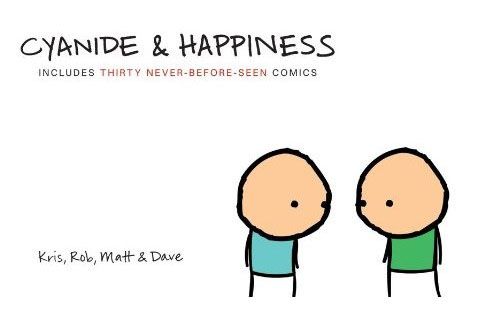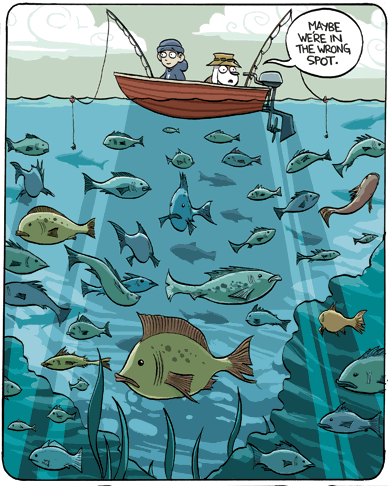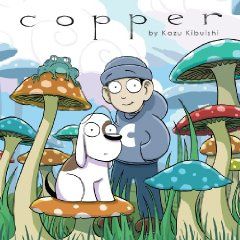While webcomics have certainly come into their own as a medium unto themselves, most creators eventually produce a print volume, either on their own or through a major publisher. Print publishers may put up part of a volume as a preview, or they may post an entire volume (as Viz does on its SigIKKI website) and then pull it down when the print edition arrives. Webcomics creators, on the other hand, generally leave the entire comic up on the web, which begs the question: Why pay for the book when the comic is free?
I recently received review copies of print editions of two well known webcomics, Cyanide & Happiness and Copper (links are to the web versions). In both cases, I had read the comic from time to time but didn't follow it regularly. And in both cases, I felt that the print edition did indeed present extra value over the webcomic. Read on to see why.
*****
By Kris Wilson, Matt Melvin, Rob Denbleyker, and Dave McElfatric
HarperCollins, 160 pages, $13.99
The Cyanide & Happiness formula is pretty simple: Stick men (and women) do shocking things to one another. There are four different artists, but the style and humor are fairly uniform; a situation is set up in the first panel and resolved, by stabbing, boob-grabbing, or shouting “You have cancer! LOL!” in the last. My kids love this comic, because it’s what teenagers are all about: Working your way through every possible taboo, in public. So in C&H we have Seizure-Man falling down and frothing at the mouth, bungee-jumping childbirth, and lots and lots of stabbing.
The danger that collecting a bunch of C&H strips into a single book, of course, is that repeated exposure will lessen the impact. One stabbing joke is funny; five of them, not so much. Fortunately, the creators pace themselves, mixing different types of humor (including some clever wordplay and visual puns that aren’t at all bloody) so that when someone gets stabbed in the forehead, it actually does come as a surprise.
Also, there’s more to Cyanide & Happiness than blood and gore. The gags really are funny, in a laugh-out-loud sort of way, and the pacing is usually spot-on. Occasionally someone is left hanging for an extra panel, but usually it works.
So why buy the book when the comic is free? A couple of reasons. One is that you don’t have to read the comics on the C&H website, where they are reproduced just a hair too small for comfortable reading and are surrounded by animated ads, raw HTML for embedding the comic in your blog, and other crap. Another is that the book only includes the best strips, saving you the trouble of paging through the weak ones. And finally, it really is a very handsome book, with a nice matte cover, bright colors, and heavy paper.
I don’t really recommend reading this book cover to cover. Better to leave it lying around the house so you can dip into it from time to time—the humor will stay fresher that way. Just be sure to hide it when Grandma comes to visit, unless she has the same sense of humor as a 15-year-old.
by Kazu Kibuishi
Scholastic, 96 pages, $12.99 (paperback), $21.99 (hardback)
Despite being published by Scholastic, Copper is not really a children’s comic. It is more like the classic Little Nemo in Slumberland, to which it pays occasional homage: These stories are accessible to children but offer a lot more to adults.
This is a comic worth reading for the art alone; in each single-page story, creator Kazu Kubuishi creates a dreamlike world for his two characters, a boy named Copper and his dog Fred, to wander through. Sometimes they are in a boat on a vast sea, or an airship sailing through the clouds. Most often they are on foot: Taking the subway through the city, hiking up a mountain, or jumping from the top of one giant mushroom to another. Kibuishi varies the size and arrangement of his panels to create a framework for the story (another echo of Little Nemo). The stories themselves are fairly simple, mostly just three or four beats, and more conversation than action.
I was a little dubious as to how this comic would transfer to paper, but the folks at Scholastic did a nice job of putting the book together, including making the very intelligent decision to put each comic on a single page rather than breaking them across multiple pages. They are perfectly readable in the book’s 9”x9” format, and in fact the book is a bit better for me, because an entire page won’t fit on my browser screen. In addition, the book features four new comics that aren’t on the web. These are more than just bonus material—each of them is several pages long and has a more complex story than the one-page episodes on the web. In a final essay, Kibuishi talks about how he works on Copper and shows photos of the work in progress.
Unlike Cyanide & Happiness, Copper reads about as well on the web as in print. What puts this book over the edge is the handsome format and the extras. The one complaint I have always had about Copper is that there isn’t enough of it—Kibuishi last updated it in April 2009—and the new comics are among the strongest in the series. And unlike Cyanide & Happiness, this is a book that can be read over and over. At $12.99 for the paperback, it’s a steal.



